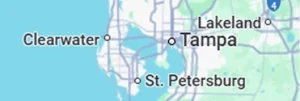
Hypoxylon (hi-póx-i-lon) cankers are prevalent and highly visible diseases affecting oaks and other hardwoods in Florida. These cankers are caused by one or more Hypoxylon fungi. Trees infected with Hypoxylon often show evidence of severe injuries on the branches or stem and/or advanced dieback or decline. The bark of infected trees typically sloughs off, often near injuries or along the trunk and major branches, revealing one of two types of fungal signs.
In the spring or early summer, conspicuous, powdery, greenish-to-brown masses of spores called conidia are produced on the surface of crusty sheets of fungus tissue called stromata.
Later in the summer or fall, after the powdery conidia are gone, the fungal stromata thicken, become very firm, appearing silver-gray, brownish to black in color. On close inspection, minute (less than 1/32″), black, slightly raised dots are visible on the surface of the stroma. These dots are the tips of small cavities, producing spores which are discharged to the air looking for the next stressed oak.
Stromata vary from a few inches to several feet in length up and down the trunks of infected trees and are the most readily recognizable indicator of Hypoxylon infections.Hypoxylon infections originate when spores come into contact with injured or stressed tissues of susceptible trees during the late summer, fall or winter. Spores are spread by wind, splashing rain and, presumably, by certain insects, birds and rodents. The fungus develops in the bark and wood tissues.
If any of your trees are showing signs of hypoxylon canker, chances are, it’s time to remove the tree so as to prevent the spread to surrounding trees and to prevent the infected tree from becoming more of a hazard.


